Why versatility is driving the use of folding construction cranes
08 February 2022
The versatility of self-erecting tower cranes and mobile folding cranes means they are both being used globally on a wide variety of construction projects, both traditional and novel. Niamh Marriott reports.
Folding construction cranes are good for a wide range of lifting applications, increasingly even beyond construction, and can be used on all sorts of projects.
The Manitowoc group with its Potain brand offers models that can lift 1.8 tonnes upwards. The brand has four production units across Europe to supply demand to its customers; at Moulins and Charlieu in France, Niella Tanaro in Italy, and Baltar in Portugal.
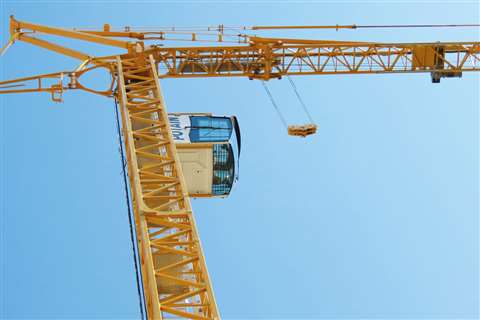 Potain tower cranes are designed to have a small footprint on site and can be configured in multiple ways
Potain tower cranes are designed to have a small footprint on site and can be configured in multiple ways
Its GMA self-erecting range has 20 models, including the Igo, Igo T, Igo M, Hup and Hup M. This type of crane is mainly intended for construction companies working on short and medium-term construction sites from individual houses to engineering structures. The range offers jib lengths from 20 to 50 metres and hook heights to 38 metres in horizontal, and even 61 metres in the raised jib position. The company concedes that, “as powerful as the GMA range cranes are, they have limits and will never be able to compete with the larger top slewing cranes.”
The latest additions to the GMA Potain range are the Hup M 28-22, and most recently the Igo T 99.
Manitowoc Potain new brands
The Hup M 28-22, the latest in the GMA range, with an integrated transport axle is very popular with carpenters’ roofers and masons, the company says. It says its integrated transport axle (25 or 80 km/h), and permanent counterweight make the crane simple and easy to transport. The maximum load is 2.2 tonnes and can still lift 850 kg at the end of its 28 metre jib.
“This crane completes our range of cranes with integrated transport axle and offers an alternative to the already very popular Igo M 14,” says a spokesperson.
The Igo T 99 was launched at the JDL equipment exhibition in France in June 2021. A telescopic crane that has automated assembly is ideal for construction sites with high constraints, the company says. This crane has a high lifting capacity of 6 tonnes (1.2 tonnes at 48 metre jib-end) and a hook height in the horizontal boom position of up to 38.5 metres, and is suitable for construction work.
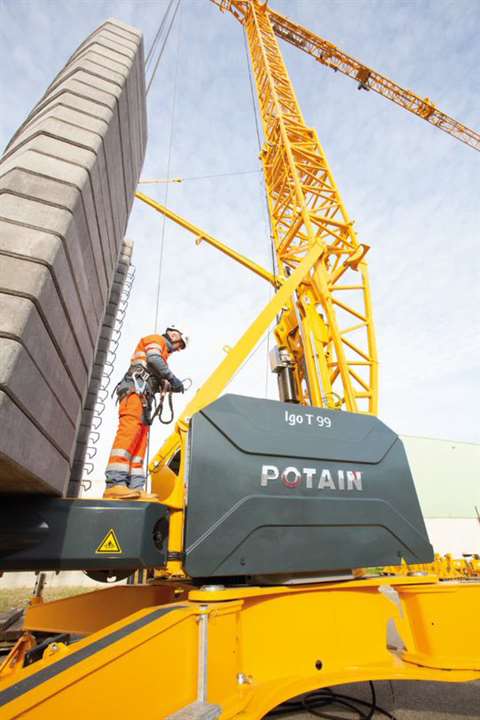 Manitowoc’s Potain Igo T 99 was launched at the JDL show in France from 23 to 25 June 2021
Manitowoc’s Potain Igo T 99 was launched at the JDL show in France from 23 to 25 June 2021
Manitowoc says that the main innovation on this telescopic GMA model is the development of a user interface called Smart Set-up which simplifies and secures the assembly and disassembly processes from the remote controller. With this system, the crane operator is guided via a colour screen directly on the transmitter of the remote controller, meaning there is no need to get closer to the electrical cabinet. The company says the operator is therefore provided with all the necessary information they may need.
“One of the main advantages of small capacity self erectors is their mobility. Our Igo M and Hup M range with integrated transport axle allows rapid transport between the different sites. The installation, assembly and dismantling of these machines, as of all our GMA is very fast thanks in particular to the remote control and hydraulic kinematics,” a spokesperson says.
“The footprint on site, the fact that these cranes operate with electric motors with frequency inverters not only limits and optimises electricity consumption but is also non-polluting compared to other construction equipment with a combustion engine,” the Manitowoc spokesperson continues.
“Thanks to their jib length, these machines make it possible to serve a construction site within a large radius from a single fixed point and therefore does not damage the surroundings of the site.”
Working in difficult and novel sites is a common challenge for crane companies to overcome. Three Liebherr cranes, a self erecting 125 K, a mobile construction crane type MK 110 and a 150 EC-B 8 Litronic flat top crane (outside the scope of this article) demonstrated the versatility of projects available for these models as they were all involved in theatre construction. The cranes worked across three European sites to assist with building and dismantling of sets, and one was even used as part of the production.
Liebherr cranes
First up, a Liebherr 125 K self erecting crane was used for the Opera Festival held at the Arena Di Verona, the Roman amphitheatre in Verona, Italy. Italian Liebherr dealer Niederstätter opted for Liebherr’s large fast erecting crane as it was easy to assemble. Various productions were staged over the summer months, which meant the imposing stage sets had to be changed several times.
The 125 K was unfolded and disassembled quickly to meet the requirements of this unique job. The crane was positioned directly on the ancient walls atop a six-metre gantry; a solution that minimised the amount of space required. A Liebherr LTM 1160/2 mobile crane lifted the fast-erecting crane onto the gantry and transported it back down at the end of the festival season.
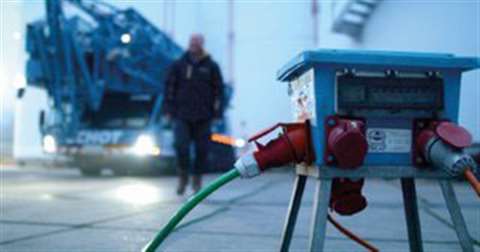 Spierings Mobile Cranes heavy crane can be powered from a 16 Amp socket
Spierings Mobile Cranes heavy crane can be powered from a 16 Amp socket
The 125 K also made a big impression with its load capacity of 1,300 kg at maximum radius. It had a reach of 55 metres, and the bottom-slewing crane was able to cover the entire stage area and completed all necessary lifts. LED jib lighting also helped with trouble-free working at night.
Germany’s largest temporary open-air theatre
Next, in Frankfurt, Germany, precision handling was paramount when a Liebherr MK 110 was deployed at Germany’s largest temporary open-air theatre, the Sommerbau theatre on the city border of Offenbach and Frankfurt. The five-axle mobile construction crane, belonging to the Eisele AG Crane & Engineering Group, provided support for the production of Dionysus City, which included several video inserts. Technology service provider Satis&Fy broadcast via a huge, 3.9 tonne LED cube. Even in windy conditions, the crane operator had to get the position exactly right so that technicians could take delivery of the cube both quickly and safely.
“The MK 110 was perfect for this task. Only this type of crane is capable of such precision handling,” says Lars Ulrich, project manager at Satis&fy. Heavy loads arrived safely on the ground with the help of intelligent assistance systems.
Spierings Mobile Cranes
The range of projects these cranes can work with is vast, and there are many options of cranes to choose from for this work, too. Electric mobile cranes are increasing in popularity, as the crane industry looks for ways to reduce its carbon footprint and perform lifting work in a more sustainable way.
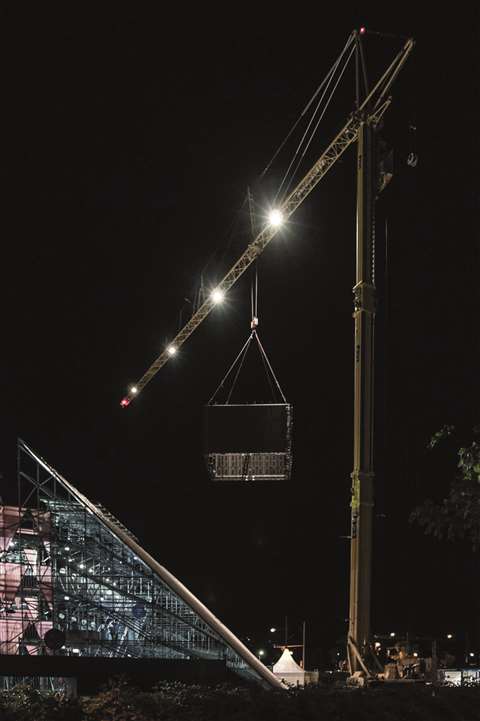 The ergonomically designed cabin also offers the crane operator a high level of comfort, which was important in the opera application as each performance lasted up to ten hours
The ergonomically designed cabin also offers the crane operator a high level of comfort, which was important in the opera application as each performance lasted up to ten hours
Sustainability isn’t only suited for smaller models and little lifts, and electricity can be used to power enormous pieces of equipment. Netherlands-based Spierings Mobile Cranes offers a six axle heavy crane which is 66 metres high yet can be powered from a 16 amp socket. The company says it is the largest electric mobile crane in the world and provides a zero-emission lift. It has an eco mode and an integrated battery pack.
Koos Spierings, CEO at Spierings, says, “Due to the integrated battery pack, peaks in energy consumption can be mediated. When the crane is not being operated for mere seconds, the hydraulic pumps will shut off reducing the energy consumption. Meanwhile the battery remains charging making it possible to operate on only a low power grid-connection most often found on construction sites.”
Hybrid technology
In the case no grid connection is available, the crane can also work in a hybrid mode where a small 3 cylinder EU Stage 5 diesel engine, together with the battery pack, will supply the crane with the required power.
Spierings says, “Lots of knowledge on hybrid technology and software was already present within our company making us able to act fast. Spierings is now offering three models that can work free of emissions.” The company has already delivered 70 eLift cranes to customers in Europe. It says it believes demand for this type of crane is increasing and that “virtually every crane that left the factory in 2021 was electric.”
Self erecting tower cranes are terrific tools for a range of projects due to their custom configurations, automated controls and intelligent systems, as well as their lifting capacities. The stage has been set and they are quickly becoming the stars of the show.
Potain in Pennsylvania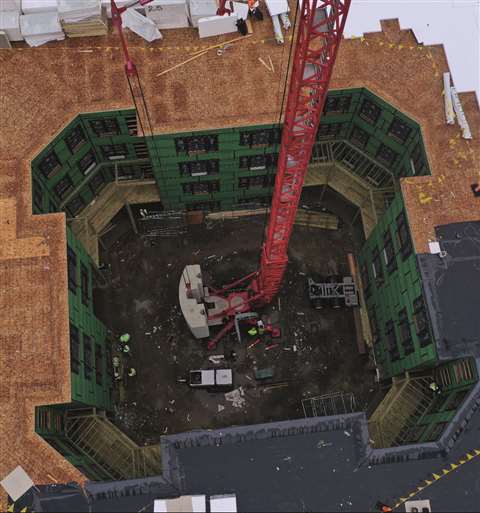
In Pennsylvania, USA, a Potain tower crane appears encased inside the courtyard of the complex it is erecting. Contractor Quality Buildings is using the crane on this challenging and restricted site in downtown Allentown. The project’s design and location in the city’s historic district posed challenges to traditional stick-build contractors. Quality Buildings was selected as the subcontractor for framing, largely due to one equipment choice it factored into its estimate: a Potain Igo T 130 self-erecting tower crane. The crane is lifting frame wall bundles measuring 3.6 x 2.4 x 2.7 metres, four stories high, each weighing more than 1,360 kg per bundle. “There really was no other piece of equipment that would work,” says Elmer Zook, president at Quality Buildings. “With the tight jobsite environment and the limited laydown space for supplies, we erected the tower crane in the middle of the building. That allows us to service the entire construction site from a single location. We can offload supplies from trucks parked along the street and place at the exact location on the building where it is needed.” “A conventional telehandler can work up to three stories, but above that it’s super hard to manage that amount of height and weight. Another advantage with the Potain is that its broad reach means the material can be placed specifically where it needs to be on the floor, rather than parked on the edge then manually moved,” Zook says. “The self erectors are also a much less costly solution than using a top slewing tower crane, especially for small to mid-size contractors.” While North America is still slow to adopt self erecting towers, the climate is shifting due to intensified labour shortages and project backlogs. “A self erector is not for every single job. A contractor needs to understand how it will work best for their operations and how to factor rental or purchase costs into estimates,” says Chad Jacobs, tower crane specialist at local Potain dealer Stephenson Equipment. “It’s a mindset shift for contractors.” For example, instead of procuring rental equipment a week ahead of a project start, planning needs to start six or seven months in advance at the bidding stage. |
STAY CONNECTED


Receive the information you need when you need it through our world-leading magazines, newsletters and daily briefings.




